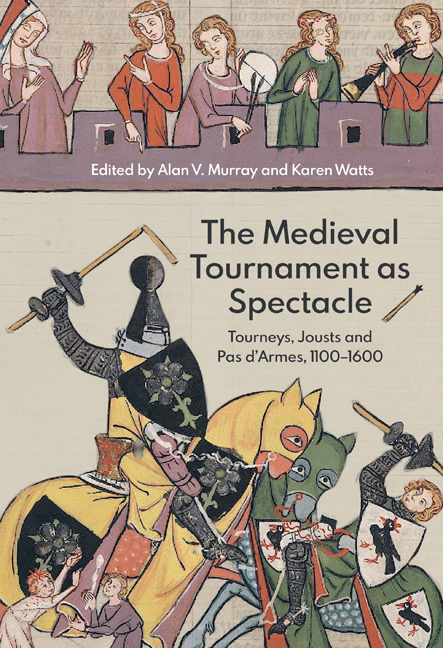Book contents
- Frontmatter
- Contents
- List of Illustrations
- List of Contributors
- Preface and Acknowledgements
- Introduction: From Mass Combat to Field of Cloth of Gold
- Research on the Medieval Tournament (1100–1600): A Select Bibliography
- 1 Now Form Up Close Together! Tactics and Ethos of the Tourney in Early German Sources (Twelfth to Thirteenth Centuries)
- 2 Por pris et por enor: Ideas of Honour as Reflected in the Medieval Tournament
- 3 Richard II of England and the Smithfield Tournament of October 1390: An Instrument to Establish Royal Authority
- 4 Alle myn harneys for the justes: Documents as a Source for Medieval Jousting Armour
- 5 The Tournament Saddle
- 6 Between Sport and Theatre: How Spectacular was the Pas d’armes?
- 7 Art Imitating Life Imitating Art? Representations of the Pas d’armes in Burgundian Prose Romance: The Case of Jehan d’Avennes
- 8 The Foot Combat as Tournament Event: Equipment, Space and Forms
- 9 Power and Pageantry: The Tournament at the Court of Maximilian I
- 10 The Field of Cloth of Gold: Arms, Armour and the Sporting Prowess of King Henry VIII and King Francis I
- Appendix 1 Calendar of the Royal Combats at the Field of Cloth of Gold, June 1520
- Appendix 2 Articles for the Challenge: The Emprise
- Index of Objects
- Index of Manuscripts
- General Index
6 - Between Sport and Theatre: How Spectacular was the Pas d’armes?
Published online by Cambridge University Press: 11 September 2020
- Frontmatter
- Contents
- List of Illustrations
- List of Contributors
- Preface and Acknowledgements
- Introduction: From Mass Combat to Field of Cloth of Gold
- Research on the Medieval Tournament (1100–1600): A Select Bibliography
- 1 Now Form Up Close Together! Tactics and Ethos of the Tourney in Early German Sources (Twelfth to Thirteenth Centuries)
- 2 Por pris et por enor: Ideas of Honour as Reflected in the Medieval Tournament
- 3 Richard II of England and the Smithfield Tournament of October 1390: An Instrument to Establish Royal Authority
- 4 Alle myn harneys for the justes: Documents as a Source for Medieval Jousting Armour
- 5 The Tournament Saddle
- 6 Between Sport and Theatre: How Spectacular was the Pas d’armes?
- 7 Art Imitating Life Imitating Art? Representations of the Pas d’armes in Burgundian Prose Romance: The Case of Jehan d’Avennes
- 8 The Foot Combat as Tournament Event: Equipment, Space and Forms
- 9 Power and Pageantry: The Tournament at the Court of Maximilian I
- 10 The Field of Cloth of Gold: Arms, Armour and the Sporting Prowess of King Henry VIII and King Francis I
- Appendix 1 Calendar of the Royal Combats at the Field of Cloth of Gold, June 1520
- Appendix 2 Articles for the Challenge: The Emprise
- Index of Objects
- Index of Manuscripts
- General Index
Summary
Picture medieval knights and squires charging towards each other on horseback, striking helmets or shields and breaking lances: it is spectacular. Men in shining armour striking each other with swords or poleaxes, and groups of men exchanging blows in a melée must have been spectacular as well, even if their weapons were blunted. Noblemen performing deeds of arms in pas d’armes during the fifteenth century competed in all three types of combat. Yet it is generally thought by those familiar with the pas d’armes that it was more spectacular than other jousts and emprises due to its theatricality.
Definitions of the pas d’armes commonly indicate that theatrical production is one of its defining features. The following passage, for example, is emblematic of definitions found both in general studies on medieval chivalry and in specialised analyses of pas d’armes: ‘This form of deed of arms, sprung from the custom of a knight holding a bridge or gate against all comers, is attested as early as the eleventh century and probably has Germanic roots. In the fifteenth century, such deeds took on the form of state theater – though the combat was no less real or intense.’ The second sentence suggests that although the pas d’armes consisted of real combat (and indeed people were hurt and occasionally killed), an accompanying theatrical production or performance was one of its defining properties. The introduction to the most recent critical edition of a pas d’armes states that a pas d’armes is half theatre, half sport, a theatrical representation with elaborate decoration and rich costumes, careful staging, and dialogues written in advance.3 However, examination of the accounts of twenty-three events commonly found in corpora established by scholars investigating pas d’armes reveals that, while many did in fact feature such theatrical representation, the descriptions of several of these events mention little or no theatrical production at all. Is it appropriate to define a pas d’armes by saying that it was a type of medieval tournament whose spectacular character was enhanced by theatrics, including actors in character and in costume performing dialogue, careful stage production, and decoration according to a fictional scenario developed in its governing document?
- Type
- Chapter
- Information
- The Medieval Tournament as SpectacleTourneys, Jousts and Pas d'Armes, 1100-1600, pp. 120 - 138Publisher: Boydell & BrewerPrint publication year: 2020



